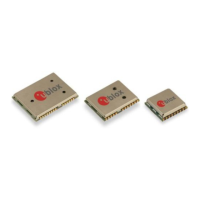LEA-6 / NEO-6 / MAX-6 - Hardware Integration Manual
UBX-14054794 Production Information Design-in
Page 48 of 85
e.g. Murata BLM18HD601SN1
e.g. Philips Semiconductors
9
Table 19: Active antenna supervisor, bill of material
Status reporting
At startup and on every change of the antenna supervisor configuration the u-blox 6 GPS/GALILEO module will
output a NMEA ($GPTXT) or UBX (INF-NOTICE) message with the internal status of the antenna supervisor
(disabled, short detection only, enabled).
None, one or several of the strings below are part of this message to inform about the status of the active
antenna supervisor circuitry (e.g. “ANTSUPERV= AC SD OD PdoS”).
Antenna Control (e.g. the antenna will be switched on/ off controlled by the GPS receiver)
Short Circuit Detection Enabled
Short Circuit Recovery Enabled
Open Circuit Detection Enabled
Table 20: Active Antenna Supervisor Message on startup (UBX binary protocol)
To activate the antenna supervisor use the UBX-CFG-ANT message. For further information refer to the
u-blox 6 Receiver Description including Protocol Specification [4].
Similar to the antenna supervisor configuration, the status of the antenna supervisor will be reported in a NMEA
($GPTXT) or UBX (INF-NOTICE) message at start-up and on every change.
Active antenna supervisor is not configured and deactivated.
Active antenna connected and powered
Antenna not connected or antenna defective
Table 21: Active antenna supervisor message on startup (NMEA protocol)
2.6.5 Active antenna (NEO-6 and MAX-6)
NEO-6 and MAX-6 modules do not provide the antenna bias voltage for active antennas on the RF_IN pin. It is
therefore necessary to provide this voltage outside the module via an inductor L as indicated in Figure 48. u-blox
recommends using an inductor from Murata (LQG15HS27NJ02). Alternative parts can be used if the inductor’s
resonant frequency matches the GPS frequency of 1575.42 MHz.
Transistors from other suppliers with comparable electrical characteristics may be used.

